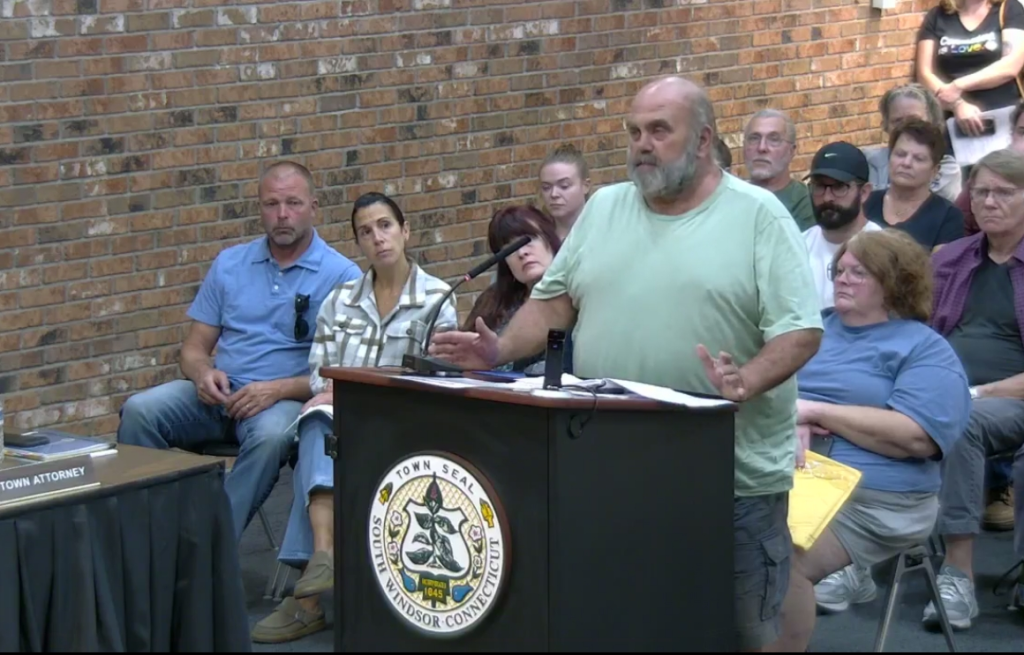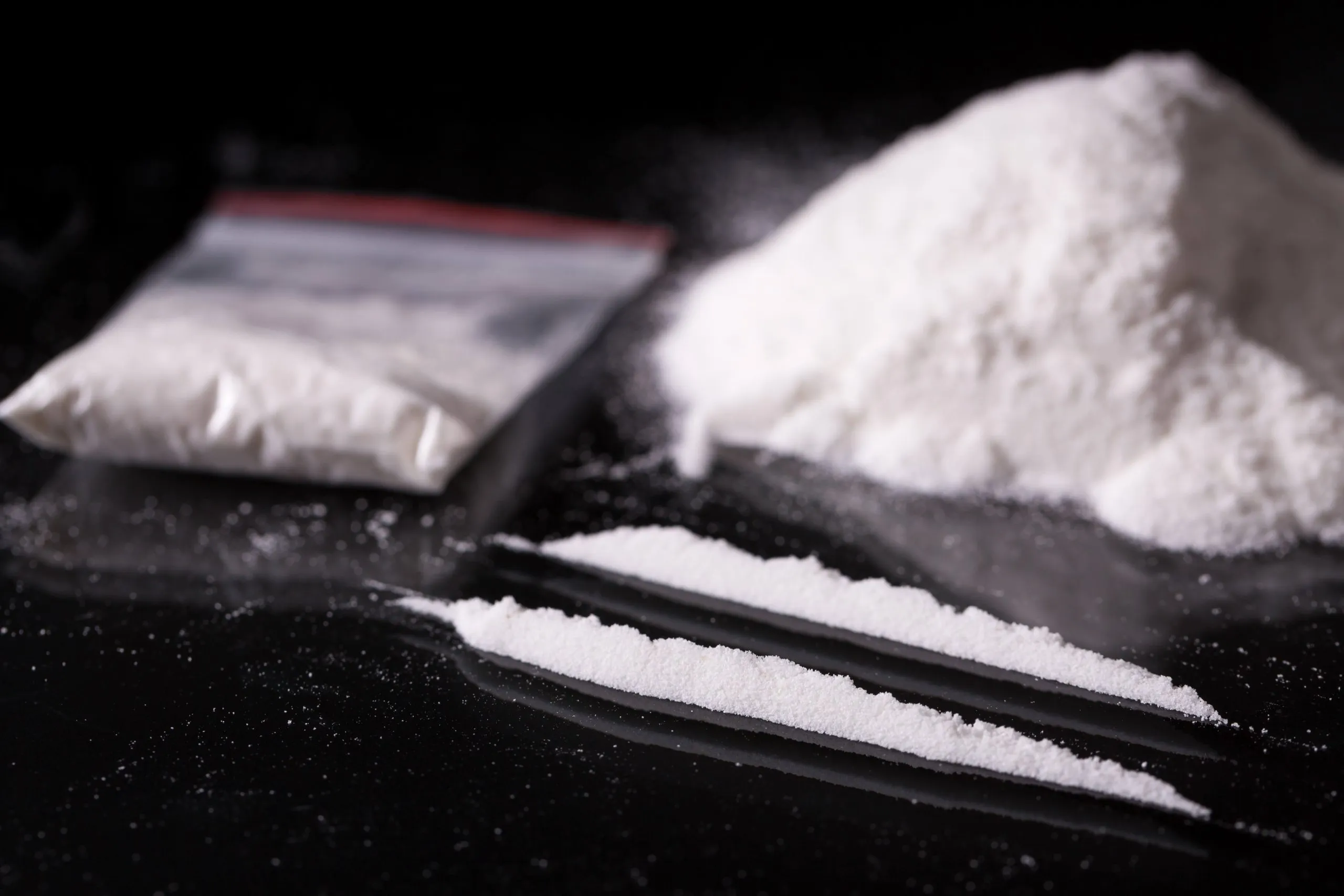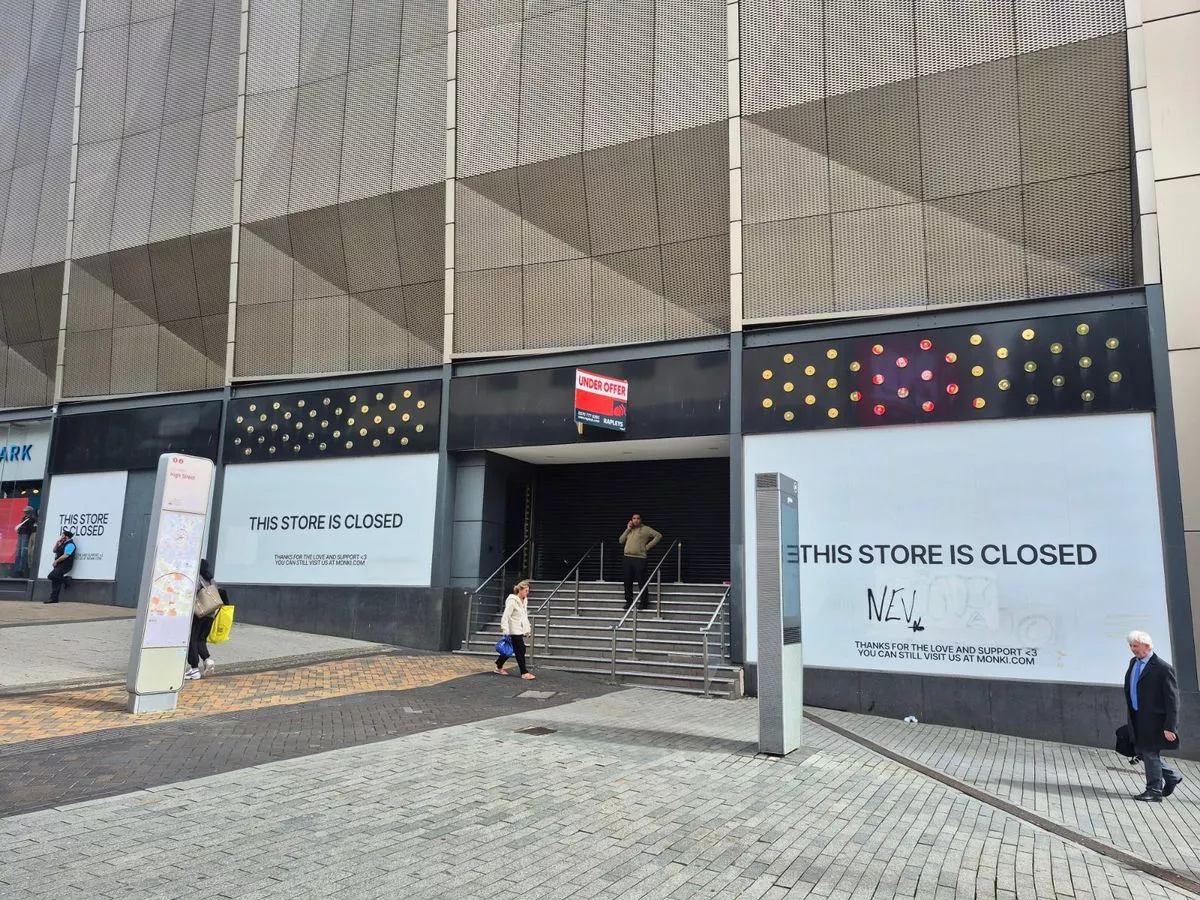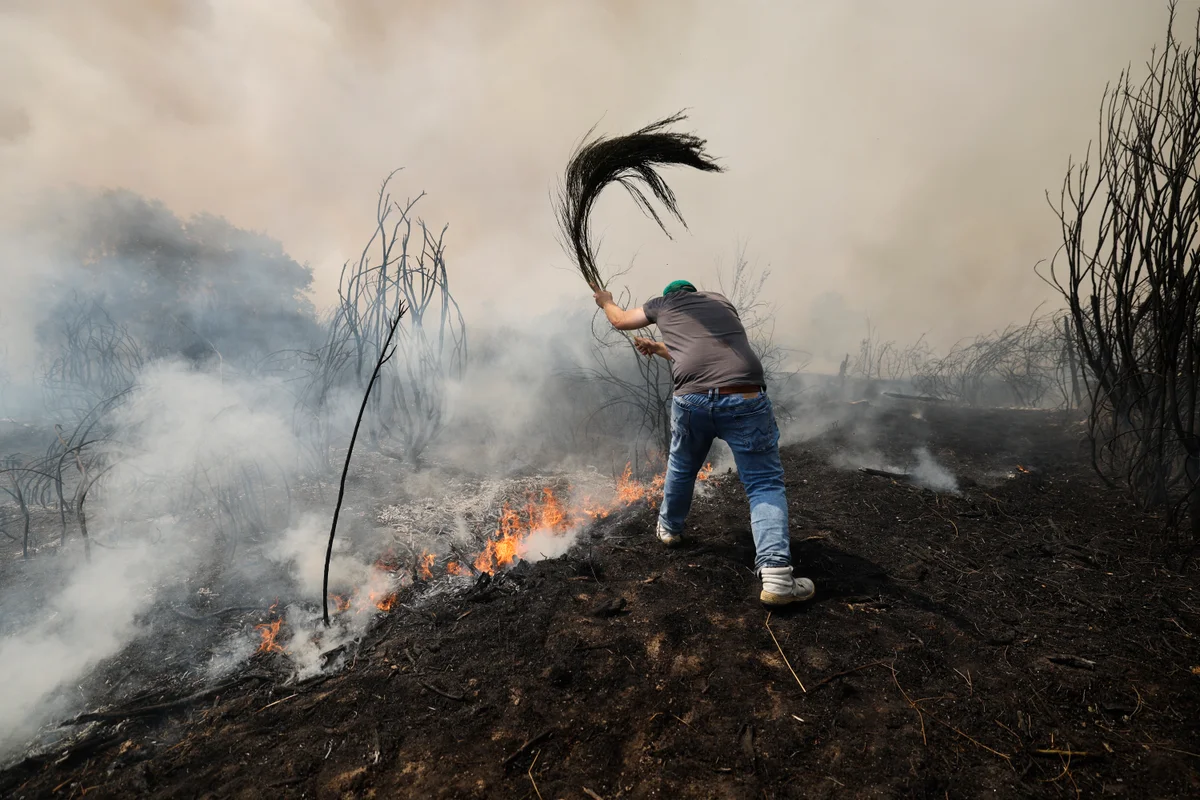
The concerns came hard and fast to the Town Council: “the system failed, mutual aid let us down,” and the town, “was not prepared.”
Those and more were the words of multiple South Windsor residents, particularly in the area of Niederwerfer Road, who voiced concerns to the council on the availability of water in the event of a fire in their neighborhood, even as the council reviews options that would cost thousands to millions of dollars.
The concern comes on the heels of the July 25 fire at Burke Ridge Farms, during which the farmhouse at 354 Niederwerfer Road burnt down. Reports from the fire department after the fire said the home was about 3,000 feet from the nearest fire hydrant.
“Now, you might say it was an old house. There were many things inside, but let’s be honest. It was a challenge with the water over the three and a half hours that that home burned,” said Kelly Juleson, who lives nearby on Homestead Drive. “The two mutual aid tankers from Broad Brook, they were down, firefighters were sent into a situation without the resources they needed. And as a result, a home was lost forever.”
Juleson spearheaded the GoFundMe for the Burke family that raised about $40,000.
Since the fire, state Sen. Saud Anwar held a forum to discuss what can be done so such a circumstance does not recur.
Burke Ridge Farms owner Bill Burke, whose family home burnt down July 25, told the council, “After the fire, I talked to the mayor, and Chief Cooney, and supposedly everything was done according to procedure and protocol.
“Well, if that is the current protocol at this town has, it really needs to be changed. There’s no tankers in the town. Everything they rely on pumpers. We were 3,000 feet from the nearest hydrant. The fire department refuses to get a tanker. There was no water. They had no water pressure,” Burke said.
Burke said, “I have no hard feelings with the fire department and its volunteers. They did their best. They came out, and they tried, but there was no water. They’re standing on my front lawn for numerous times…with no water. There’s something wrong.”
A good portion of the more than two-and-a-half hour Town Council meeting was used to discuss the water issue, including that council members were able to question South Windsor Director of
Public Works Vincent Stetson, South Windsor Fire Chief Kevin Cooney and Town Manager Michael Maniscalco.
The three answered questions about a memo with five options (a sixth was later added) for the town council to consider about the three dozen homes on Niederwerfer Road. Nothing was finalized Monday; the town council was interested in reviewing cost-effective options.
“On Friday, July 25, 2025, a structure fire occurred on Niederwerfer Road. Following the
incident, concerns were raised by some residents regarding the adequacy of the fire
event water supply in this area. In response, an analysis has been conducted to
evaluate potential alternative water sources to support fire suppression efforts in future
incidents,” the memo said.
South Windsor Mayor Audrey Delnicki met with residents, and she said the residents’ suggested options were brought to the town manager. The memo was generated by the fire department, building department, fire marshal’s office, public works and planning and zoning departments.
The five options in the memo are:
Extending municipal water main on Niederwerfer Road
This option has an estimated cost of $4 million and would “provide a reliable and continuous water source for firefighting and other municipal needs, however will be extremely cost prohibitive for taxpayers and that water access may encourage urban development in a predominantly rural area”, according to the memo.
Purchase additional fire tanker truck
The estimated cost would be $1 million and would increases the Fire Department’s capability to respond to fires in areas without hydrant access. The cons would be high capital expense for a depreciating asset with a finite lifespan; perpetual maintenance costs for a non-primary response vehicle; potential challenges in housing the vehicle within existing firehouse facilities and mutual aid agreements already provide tanker access from neighboring towns, according to the memo.
Installation of underground water cistern
The estimated cost is $220,000 and would add localized fire suppression water capacity in the Niederwerfer Road area. The cons the memo cites are significant cost to taxpayers, permitting difficulties due to proximity to conservation-designated land on Niederwerfer Road and additional soils analysis needed to determine a suitable siting location for tank.
Installation of above-ground water storage tank
The estimated cost would be $120,000, which would provide firefighters with a localized water source. Listed cons of this choice on the memo include siting and permitting challenges on conservation land on Niederwerfer Road and additional soils analysis needed to determine suitable siting location for tank. This option would also require ongoing maintenance, a power source for winterization and has a life expectancy from 30 to 50 years.
Installation of dry fire hydrant and associated water source (e.g., a pond)
The estimated cost would be $25,000 and would be installed using town staff. The most cost-effective option. The listed cons are seasonal water availability, and it may be dry during critical periods as well as environmental and permitting challenges based on location and land ownership.
There was a lot of discussion about the price of options and who would pay the costs.
“In this instance, if the town were to elect to install a watermain down Niederwerfer Road, the town taxpayers would be picking up the lion’s share of the cost,” Stetson said. “Any resident on Niederwerfer Road, if they wanted to connect to the water main would have to pay a connection fee.”
Maniscalco said expanded waterlines in town would be overseen by the Public Utilities Regulatory Authority.
“PURA requires water companies to have customers on that line pay for the expansion,” Maniscalco said. “That being said, if the town wants to pay for the expansion, they can. But that means the 27,000 residents in town will pay for the expansion.”
Maniscalco said connection charges “can be pretty steep” but did not name a figure. He said the total he estimates he received from Connecticut Water for the project was between $4 and $4.4 million. He said no state or federal funds would be available unless there were a public health crisis such as water contamination.
Maniscalco said there are 19 areas of South Windsor that are 2,000 feet or more from a hydrant and it would cost an estimated $76 million to bring them all closer to homes.
Cooney said, about the water tanker idea, that he’s “not a fan of this option as a chief or a taxpayer.”
“We carry over 5,000 gallons on our current fleet, we have a great mutual aid system. We have a great training program,” Cooney said. “Every fire is different. I’m very confident should another fire arise, we will do our best. Any additional tankers aren’t necessarily going to make a big difference.”
“Nineteen streets in our town is a very small percentage and I can tell you have had fires in those other areas without any issues with our own current system with the water that we carry and the hydrants that we do use,” he said.
Cooney said that if the tanker were the option chosen, it would be three to five years by the time the tanker would be in use.
With the large price tag for the first two options, several town council members were interested in learning more about options three, four and five and about the speed, efficiency, affordability and approvals the town would need. The council asked the Stetson to do a paper review of these options for a future meeting.
Another council member asked Stetson to look into a possible sixth option of a deep well and what a cost that would be to the town. That option will be researched as well.
Cooney added that an option residents could do on their own would be installing sprinklers in their homes that could minimize the spread of fire.
Cooney said that the two tankers were unavailable the day of the Burke Ridge Farms fire was a “hiccup” and it wasn’t a breakdown in communications between departments and they weren’t given advanced notification that those tankers were down.
“Having tankers in our system are a great tool to have for most fires but every fire is different, and I don’t think the outcome would have changed,” Cooney said.
Juleson called on the council to act and do so quickly.
“It’s been 52 days. I hope that this body will act, not just with sympathy for the Burkes, but with urgency for every family and every farm that calls this town home,” she said. “Farms shouldn’t have to wonder if help will come when fire strikes. Families shouldn’t have to pray that the system doesn’t fail them, and no one should ever again lose their home or their livelihood because the town is, unfortunately unprepared. Please do not let another home be lost. Do not let another farm family suffer the way the Burkes have.”
Matthew Siracusa, who lives at Niederwerfer Road, and witnessed the Burke’s fire in July, said he feels like he’s a “sitting duck.”
“I’m now fearful that I may be next,” Siracusa said. “Basically, there’s no access to water where I’m at. By the time they set it up and get going, the house is going to be gone. And to me, that’s unacceptable. I think it’s unacceptable for my neighbors, your neighbors, we’re all residents of this town, right? But I also think it’s unacceptable for the fire department. Those are men and women that have agreed to serve and protect us, and we’re not giving them the resources they need to fight a fire on our street. It’s not their fault…I know we’re just a few dozen houses, right? But that doesn’t matter. We all deserve, we all pay the same amount of taxes, we all deserve the same amount of resources that the rest of the town has.”
Burke said he has two 12,000-gallon water tanks on his driveway he would be willing to offer to the fire department to use as a water source if there was ever another fire on Niederwerfer Road.
Cooney later said he knows no other local department or departments across the country that draws from private tanks for water. He said his department doesn’t know what’s in those tanks and his firefighters are not trained to take from those tanks. Burke invited Cooney to test them.
An email submitted to the council by Niederwerfer Road resident Dale Willard stated that a study was done eight years ago to see how much pressure and flow was available to fight a fire on the street, and “we were told at the time the results were dismal.”
“We would be interested in seeing documented conclusions resulting from that study. I don’t know why something wasn’t done then and not wait until a home burned down…We asked the town council, how do we resolve the situation,” he wrote. “Whether it be a pond, holding tanks, cisterns, or any other engineered water delivery method that can be devised to protect our homes, providing us with the same fire protection, other neighborhoods in town with hydrants depend on. We pay the same taxes as the rest of the town, and though we don’t have water, sewers, curves, or sidewalks, basic fire protection is a must.”



